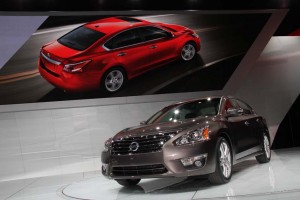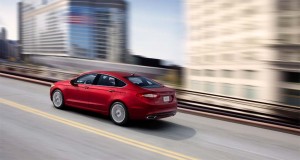Potential buyers are getting a first good look at the new 2013 Nissan Altima, this week, at the New York Auto Show where it is making its global debut. Betting show-goers will like what they see – especially the 38 mile-per-gallon highway mileage number — the Japanese maker is betting it can jump from midsize also ran to a leader in the critical automotive segment.
“We are expecting to compete at the top level, and we are going to take a shot at being number one in the segment,” says Nissan CEO Carlos Ghosn.
Industry analysts anticipate Nissan will, indeed, gain some ground with the launch of the more stylish and fuel-efficient Altima. But they caution that the maker can’t take things for granted. It is far from the only manufacturer looking to gain ground in the midsize market – which is expected to generate nearly one in six new vehicle sales in the U.S. market this year.
Chevrolet has already gotten off to a good start with the high-mileage version of its 2013 Malibu, with other variants launching later this year. Ford, meanwhile, is expecting big things to come from the Fusion sedan it unveiled to much acclaim at the Detroit Auto Show in January. Honda is readying an all-new version of its long-popular Accord. And, after a slow start, Toyota last month saw a huge rebound for the Camry it introduced for the 2012 model-year.
“It is an incredibly competitive segment,” stresses IHS Automotive analyst Rebecca Lindland and, if anything, getting all the more competitive.
Passenger cars, in general, are gaining ground as U.S. motorists began to migrate back from pickups, SUVs and other light trucks due to near-record fuel prices. There’s still a strong market for car-based crossovers, but passenger cars, on the whole, are now generating a bit more than half of all sales after several decades in the minority.
IHS is forecasting the midsize segment will grow at least 5%, to around 2.1 million for all of 2012, with a market share of around 16%. That’s actually down slightly from 2010, Lindland notes, because “We’re seeing an increasing in sales of even smaller vehicles.”
But midsize models still represent a large and profitable segment that few manufacturers dare ignore – including Detroit’s Big Three, who were long little more than laggards, a significant share of their midsize sedans traditionally dumped into low-volume rental fleets.
The outgoing Malibu model began to gain ground, as has the old Fusion, with more and more of them sold to retail buyers. The same is true for Hyundai’s highly stylish Sonata. The Korean offering nearly doubled sales between 2008 and 2011, jumping from 118,000 to 226,000 – and the maker says it would have done even better last year were it not for severe production constraints.
On the other hand, the segment’s traditionally dominant players have been losing ground. “This has been the bread-and-butter for Toyota and Honda for decades,” says Lindland, noting they could routinely count on generating sales in the range of 400,000 annually.
But where Toyota sold 441,000 Camry sedans as recently as 2007 it could only generate sales of 309,000 last year. Honda saw demand plunge from 392,000 to 236,000 during the same period. And the downturn in the U.S. automotive market does not itself explain that dip. Bother models experienced significant declines in share.
“We had a very good month,” in March, boasts Bob Carter, head of the Toyota brand’s U.S. sales operation. In particular, there has been strong demand for the sportier Camry SE model, which has resulted in a surprising drop in the age of the sedan’s average buyer – something that maker’s aim for.
But critics also note that the new Camry – widely faulted for its lackluster styling – has required a hefty investment in advertising, as well as significant sales incentives to get moving, with Toyota putting more of the 2012 model into fleets than in past years.
As for Honda, the maker desperately needs to get the new Accord out there. The old model has suffered an even more substantial drop than the Camry did in its final year on the market.
On the other hand, Nissan actually gained ground with the outgoing Altima, which last year pushed past Accord for the first time, generating 269,000 sales.
That’s a major reason for Ghosn’s enthusiasm about the new Altima. While not quite as radically restyled as Ford’s 2013 Fusion, Nissan has clearly upped its design game. At the same time, it took the opportunity to make some other major changes, slashing 100s of pounds off the new model, which it expects will be the lightest vehicle in the midsize segment.
That’s one reason it will be able to hit an estimated 38 mpg on the highway – better than even models like the Ford Fusion and the Chevy Malibu, which carries a hefty premium for its high-mileage package.
Nissan has capacity in place to produce at least 300,000 of the next-gen Altimas annually in the U.S. and could nudge that to as much as 400,000 if demand is there,
But the competition won’t walk away without a fight. Even Volkswagen, long shunned by most American midsize buyers, is back in the game with the all-new sedan it introduced for 2012. It marked the first time VW specifically developed a midsize model for the U.S. market – and the first time in a quarter century the maker had an American plant to produce it. VW is already preparing to ramp up production based on initial demand.
Which means that the coming year could see the biggest shoot-out in midsize market in decades – and one that only the American motorist is guaranteed to win.


